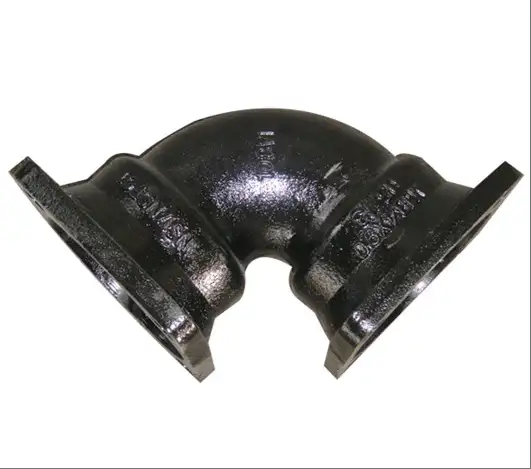When selecting ductile iron components for water and wastewater systems, understanding the differences between AWWA C151 and C153 standards is essential. AWWA C151 pertains to centrifugally cast ductile iron pipes, while AWWA C153 covers compact ductile iron fittings. This article provides a detailed comparison of these standards, highlighting their specifications, applications, and compliance requirements to assist engineers and contractors in making informed choices.

1. Overview of AWWA C151 Standard
AWWA C151, also known as ANSI/AWWA C151/A21.51, specifies the requirements for ductile iron pipes that are centrifugally cast for use in potable water, raw water, wastewater, and reclaimed water systems. The standard covers pipes ranging from 3 inches to 64 inches in diameter. These pipes are designed to withstand internal pressures and external loads, ensuring durability and reliability in various applications.
Key Specifications:
-
Material: Ductile iron conforming to ASTM A536.
-
Manufacturing Process: Centrifugal casting.
-
Joint Types: Push-on and mechanical joints.
-
Pressure Classes: Various classes based on wall thickness and diameter.
Applications:
C151 pipes are commonly used in municipal water distribution, wastewater collection, and industrial processes due to their strength and longevity.
2. Overview of AWWA C153 Standard
AWWA C153, or ANSI/AWWA C153/A21.53, outlines the requirements for compact ductile iron fittings used with ductile iron pipes or pipes made of other materials with similar outside diameters. These fittings range from 3 inches to 64 inches in size and are designed for conveying potable water, wastewater, and reclaimed water.
Key Specifications:
-
Material: Ductile iron per ASTM A536.
-
Design: Compact fittings with reduced laying lengths.
-
Joint Types: Mechanical joints, push-on joints, and flanged joints.
-
Pressure Ratings: 350 PSI for 3″-24″, 250 PSI for 30″-48″, and 150 PSI for 54″-64″.
Applications:
C153 fittings are utilized in systems where space constraints exist or where a more compact design is beneficial, such as in retrofitting existing pipelines or in areas with limited installation space.
3. Comparative Analysis: AWWA C151 vs. C153
| Feature | AWWA C151 | AWWA C153 |
|---|---|---|
| Component | Ductile Iron Pipe | Ductile Iron Fittings |
| Size Range | 3″ – 64″ | 3″ – 64″ |
| Manufacturing | Centrifugal Casting | Compact Design |
| Joint Types | Push-on, Mechanical | Mechanical, Push-on, Flanged |
| Pressure Ratings | Varies by class and diameter | 350 PSI (3″-24″), 250 PSI (30″-48″), 150 PSI (54″-64″) |
| Applications | Water distribution, wastewater systems | Space-constrained installations, retrofits |
This comparison highlights that while both standards cater to ductile iron components in water systems, C151 focuses on pipes, and C153 emphasizes fittings, each with specific design and application considerations.
4. Installation Considerations
AWWA C151 Pipes:
-
Trenching: Requires adequate trench width and bedding to support the pipe.
-
Joint Assembly: Ensure proper alignment and lubrication for push-on joints.
-
Handling: Use appropriate lifting equipment to prevent damage.
AWWA C153 Fittings:
-
Space Constraints: Ideal for installations with limited space due to compact design.
-
Joint Compatibility: Ensure compatibility with existing pipe materials and joint types.
-
Support: Provide adequate support to prevent undue stress on fittings.
Proper installation practices are crucial for both C151 pipes and C153 fittings to ensure system integrity and longevity.
5. Compliance and Quality Assurance
Adhering to AWWA standards ensures that ductile iron components meet industry benchmarks for quality and performance. Manufacturers must conduct rigorous testing, including pressure tests and dimensional inspections, to certify compliance. Additionally, third-party certifications and audits may be employed to validate adherence to these standards.
6. Frequently Asked Questions (FAQs)
Q1: What are the main differences between AWWA C151 and C153 standards?
AWWA C151 pertains to centrifugally cast ductile iron pipes, focusing on their dimensions, pressure classes, and applications in water systems. In contrast, AWWA C153 covers compact ductile iron fittings, detailing their design, pressure ratings, and suitability for space-constrained installations.
Q2: Can AWWA C153 fittings be used with pipes other than those specified in AWWA C151?
Yes, AWWA C153 fittings are designed to be compatible with ductile iron pipes and other pipes with similar outside diameters, provided that the joint types and pressure ratings are compatible.
Q3: How do pressure ratings differ between C151 pipes and C153 fittings?
C151 pipes have pressure ratings that vary based on their class and diameter, while C153 fittings have standardized pressure ratings: 350 PSI for sizes 3″-24″, 250 PSI for 30″-48″, and 150 PSI for 54″-64″.
Q4: Are there specific applications where C153 fittings are preferred over C151 pipes?
C153 fittings are preferred in scenarios where space is limited, such as in retrofitting existing systems or in areas with tight installation constraints, due to their compact design.
Q5: What joint types are available for C151 pipes and C153 fittings?
C151 pipes typically use push-on and mechanical joints, while C153 fittings offer mechanical, push-on, and flanged joint options, providing flexibility in system design and installation.
Q6: How do I ensure compliance with AWWA standards during installation?
To ensure compliance, use components certified to the relevant AWWA standards, follow manufacturer installation guidelines, and conduct appropriate testing and inspections during and after installation.
References:
1. ANSI/AWWA C151/A21.51-19 – Ductile-Iron Pipe, Centrifugally Cast, for Water
2. ANSI/AWWA C153/A21.53-18 – Ductile-Iron Compact Fittings for Water Service
3. ASTM A536 – Standard Specification for Ductile Iron Castings
4. Ductile Iron Pipe Research Association (DIPRA) – Standards and Design

